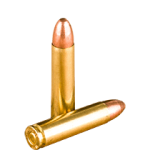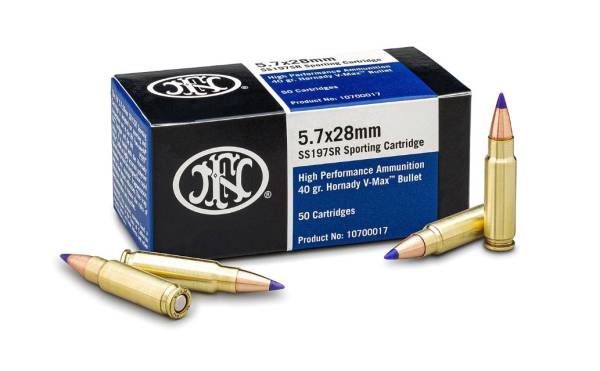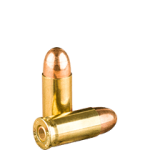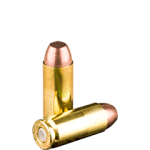Description
At first glance, the relatively straight, rimless case of the .30 Carbine may lead unknowing shooters to believe the ammunition was designed for a pistol. Afterall, it looks more like a handgun round than one made for a rifle, but that’s not the case.
No, the 7.62x33mm round was created as a light rifle cartridge originally requested in 1938, and would eventually become the most produced small arm for the U.S. Military during the Second World War.
The .30 caliber cartridge features a round nose lead bullet with a diameter of 7.62mm, or .308 inch. The slightly tapered case has a neck diameter of .331 inch and a base diameter of .354 inch. The case has a length of 1.290 inches and an overall length of 1.650 inches.
Designed by Winchester, the ammunition features a small rifle primer and has a maximum pressure of 38,500 pounds per square inch (psi). In its original form, .30 Carbine ammo has a 110 grain full metal jacket (FMJ) bullet that reaches a velocity of 1,990 feet per second (fps) and an energy of 967 foot pound (ft·lb) force.
Although it’s most often referred to as the .30 Carbine, shooters may also come across the ammo labeled as:
.30 M1 Carbine
.30 SL (where SL stands for self loading)
.762x33mm
.30 Cal ammo
.30 Cal Carbine ammo
M1 ammo
.30 ammo
The Development of .30 Carbine Ammo
It was 1938, and the U.S. military had received a plethora of reports from the field. The M1 Garand rifle, the standard long-gun of the Armed Forces, was simply too cumbersome. It was large. It was heavy. And it got in the way of soldiers, impeding their mobility.
The Army needed a carbine, something that proved to be a better warfighting tool, specifically for its ammunition carriers, machine gunners, mortar crews, and administrative and communications personnel. It needed more range and power than the M1911A1, the Army’s standard issue .45 ACP pistol, and it needed to be lighter than the M1 Garand.
It was this need that led to what has become known as the “light rifle project.”
Finally, in June of 1940, then US Secretary of War Henry Stimson ordered the development of a lighter rifle. The request included that the carbine weigh five pounds or less (which was about half the weight of the M1 Garand rifle and Thompson submachine gun) and fire a bullet with a diameter of at least .27 caliber. At 300 yards, the bullet should remain effective and have a mid-range trajectory ordinate of 18 inches or less.
While different firearm manufacturers set out to create the new weapon, Winchester was contracted with the job of creating the ammunition.
Edwin Pugsley, a designer at Winchester (and, irrelevant to his ammunition career, the inspiration for the Addams Family character, Pugsley), took the self-loading .32 Winchester cartridge, turned the rim down, and used it as the base for the new cartridge. He fitted the rimless case with a round nose .308 caliber bullet. Like the military issue full metal jacket ammo for the .45 ACP, the lead bullet was covered in copper.
The ammo, from its first production, propelled a bullet weighing 120 grain (gr) at a velocity of 2,000 fps. The first 100,000 rounds were head stamped with “.30 SL” for self loading.
This lighter bullet, which contained more modern powder than its predecessor, traveled 600 fps faster and was 27 percent more powerful than the .32 Winchester self-loading ammo.
From .30 Caliber Ammo to M1 Carbine
While Winchester was focusing on .30 Carbine ammunition, the company was also working on its Model M2 Rifle chambered in .30-06 for the military. Because of these projects, the firearm manufacturer didn’t provide a prototype for the U.S. Ordnance Department’s “light rifle project.”
Even though multiple carbines were tested, none of the prototypes made the cut. Some failed in accuracy, while others didn’t come close to meeting the requested five-pound weight limit.
Army Colonel Rene R. Studler, who was also the Chief of Research and Development of Small Arms, convinced Winchester to modify its current project, the .30-06 Model M2, and scale it down for the new .30 caliber cartridge.
Winchester did. And 13 days later, the company showed up with its prototype. It was a success, and the M1 Carbine was officially on its way to manufacturing.
Initial Army testing began in August of 1941. After proving its effectiveness, mass production of the M1 Carbine began. And over the next few decades, over six million M1 Carbine firearms were manufactured.
Although Winchester created both the ammunition and the firearm, they weren’t the top producer of the M1 Carbine. On December 8th of that same year, the U.S. military joined the war in the Pacific. Three days later, on December 11th, Germany declared war on the U.S., entering the nation into the European battle. The country was officially a part of World War II.
Entering into the war meant more guns were needed – more than any one gun manufacturer could create. Industries all over the country set aside their products and started providing weapons the military needed, including the M1 Carbine.
The Inland Division of General Motors was the top producer of the light rifle, Winchester the second. Other notable M1 Carbine manufacturers included IBM, Underwood Typewriter Company, and Rock-Ola Manufacturing Corporation, which was made famous for its jukeboxes.
The M1 Carbine was issued to infantry, machine gun, artillery, and tank crews, paratroopers, and line of communication soldiers. The semi-automatic Carbine was issued with a 15-round magazine and featured a wooden stock.
The M1A1 Carbine was made specifically for paratroopers and featured a folding stock and a leather cheek piece. Although the stock wasn’t as strong as it could be, the M1A1 Carbine provided a compact and easy-to-carry firearm for airborne units.
Another version, the M2 Carbine, looked and functioned just like the M1, but offered selective firing (soldiers could use the gun as either a semi-automatic or fully-automatic). The M3 Carbine, the final military version of the weapon, included the set-up for the infrared Sniperscope instead of the traditional iron rear sight. The M3 became the first night vision firearm used by the U.S. Armed Forces.
The U.S. Army’s Weapon Naming System
It can be helpful to have a basic understanding of how the Army names its weapons. Starting before WWII, Army weapons were classified by types – such as rifles, carbines, pistols, and tanks.
The official name of each weapon starts with its type, followed by a model number. So, there’s Carbine, Model 1, which is often referred to as the M1 Carbine. There’s the Rifle, Model 16, that’s called the M16 Rifle.
An A is sometimes added to the name, M1A1 Carbine, which means alteration. In this case, it’s the Carbine, Model 1, Alteration 1, which was specifically designed for paratroopers. Some weapons may have an E, for experimental, which is used for modifications that are still in the testing stage and not yet accepted.
The Navy, and therefore the Marines, use a different weapon classification system.
.30 Cal: An Ammunition Designed for War
The U.S. military used the M1 and M2 Carbine in wars from the early 1940s through the 1970s, including:
World War II
Korean War
First Indochina War
Vietnam War
The rifle did not fare well during the Korean Conflict, as it was said to function poorly in the cold. Bullets from the .30 Carbine struggled to penetrate the Chinese and North Korean soldiers’ heavy winter clothing and soldiers were less effective in battle.
Yet, even with these limitations, the U.S. military continued to use these carbines until replacing them with the M16 and its variants in the 1970s.
Performance of .30 Carbine Ammo
When shot from the M1 Carbine with an 18-inch barrel for which it was designed, a 110 gr bullet can be expected to travel at 1,990 fps with an energy of 967 ft·lb force. It doesn’t come close to reaching the performance status of the .30-06 cartridge for the M1 Garand Rifle, which shoots a 152 gr bullet at a velocity of 2,805 fps with an energy of 2,655 ft·lb force.
The .30 Carbine wasn’t meant to reach those standards. What it does come close to is a .357 Magnum bullet shot from a carbine with an 18-inch barrel. Its performance with an 110 gr bullet is as follows: the projectile can reach a velocity between 1,718 and 2,092 fps and an energy of 720 to 1,215 ft·lb force.
With today’s standards, the .30 Carbine reaches about half the muzzle energy as a .30-30 deer rifle and about one-third of the energy of a .30-06 rifle.
Today’s Uses for the .30 Carbine Ammunition
To a moderate degree, civilian shooters have adopted the .30 Carbine. It’s grown popular with collectors, hunters, sports shooters, and re-enactors. Hunters use it for small- and medium-sized game and large varmint including coyote, fox, and javelina.
As a hunting ammunition, the .30 Carbine has a range up to a 150 yards and handles similarly to a .357 Mag lever-action rifle. Although it has significant power, it provides inadequate energy for hunting whitetail deer.
Although it can harvest smaller species of deer, hunters should check local ordinances before using this ammo, as some states prohibit its use on deer.
The .30 Carbine has also become popular as a home-defense round. To improve its effectiveness, ammunition manufacturers have created self-defense and protection rounds in the caliber, including hollow points and ballistic options.
The M1 Carbine
By far, the most popular firearm chambered for the .30 Carbine is the M1 Carbine issued to the American Armed Forces. Officially called the United States Carbine Caliber .30, M1, this semi-automatic small rifle has been used not only in the U.S. military, but also by armed forces around the world, including the:
British Army
German Army
Japanese Army
French Army
South Vietnam Army
Although archaic by some standards, there are many places the M1 Carbine is still in use as a military-issued carbine. This includes Bolivia, Brazil, Israel, Italy, and South Korea, among others.
In 1963, the U.S. government released M1 Carbines to civilians. Most of these weapons were sold through the National Rifle Association (NRA) to its members. The carbines sold for $20 each, which included shipping and handling.
Other Firearms Chambered for .30 Carbine Ammo
Several other rifles and pistols have been chambered for this cartridge. In 1944, Smith & Wesson created a hand-ejector revolver that fired .30 caliber ammunition. Although it reached 1,277 fps and produced 4.18-inch groupings at 25 yards, the military wasn’t interested. It was simply too loud.
But other firearms followed, including the:
Marlin Model 62
Thompson Center Contender
Plainfield Machine Enforcer
Ruger Blackhawk Revolver
AMT Automag III
Taurus Raging Thirty
Types of .30 Carbine Ammo
Aguila, Federal, Magtech, Remington, and Winchester are some of the more prominent manufacturers to offer .30 Carbine ammunition today.
Bullets most commonly weigh 110 grains and leave the muzzle traveling about 2,000 fps. Bullet configurations include:
Full metal jacket (FMJ): The full metal jacket round features a lead bullet covered, or jacketed, in a harder metal, most often copper. This copper allows the bullet to keep its shape as it travels toward its target.
Soft point: The soft point round features a lead projectile, covered in the copper jacket, much like the FMJ. But at the ammo’s tip, the lead is exposed. This “soft point” allows the bullet to expand on impact, reducing penetration and increasing stopping power.
Hollow point: The hollow point .30 Carbine cartridge features a jacketed bullet. But instead of being spherical in shape, the bullet has an inverted point that reaches to the inside of the projectile. This creates a massive and uniform expansion in the bullet, making it more deadly, while decreasing the risk of over-penetration.
Flex Tip Technology (FTX): Designed and manufactured by Hornady, FTX bullets are the modern shooter’s hollow points. Using new ballistic technology, these bullets combine consistency and performance to bring shooters the best in self-defense and hunting rounds. They’re designed to have a high velocity and to create deep wounds.
Cheap .30 Carbine ammunition can be difficult to find at a local gun store, where rounds typically cost between 40 and 60 cents each. Military surplus .30 Carbine ammo is sometimes available. Some specialty loads cost considerably more.
Handloading .30 Carbine cartridges provides a good alternative and allows shooters to create specialized wildcat cartridges based on the round.
Since its beginning through today, the .30 Carbine has proven itself a cartridge that functions as a jack of all trades. The bullet is large in diameter, travels at a moderate velocity, and is effective for protecting the home and hunting most game of small to medium size.
Many rifles and pistols are chambered for .30 Carbine and come in a variety of different action types. And since the .30 Carbine generates mild recoil and is adequately accurate, its features make this cartridge a great choice for new shooters or those who want a fun centerfire cartridge for plinking.
FAQ
What is 30 Carbine ammo?
The .30 Carbine is a light rifle cartridge that was the most produced small arm by the U.S. military during World War II and is still popular today. It features a round nose .308 inch diameter bullet. In its original formation, the .30 Carbine had a 110 grain full metal jacket projectile that could reach a velocity of 1,990 feet per second and an energy of 967 foot pound force.
How can you reload .30 Carbine ammo?
The .30 Carbine is reloadable and many handloaders are fond of making wildcat rounds out of the light rifle cartridge. With soft point bullets, hand loaded rounds can come close to reaching the ballistics of .357 Magnum cartridges. And at short range, some wildcat .30 Carbine rounds can equal the performance of the .223 Remington for small game and varmint hunting.
What is the availability of .30 Carbine ammo in the future?
Although the .30 Carbine had its most fame during World War II, it is still popular today and ammunition is readily available. Many popular ammo manufacturers produce .30 Carbine rounds, including Federal, Prvi Partizan, Tula Ammo, and Sellier and Bellot. Starting at $0.45 a round, the .30 Carbine is cheaper than .30-06 and .45 Long Colt ammo.
What NATO ammo is equal in size to .30 Carbine ammo?
The NATO version of the .30 Carbine is the .30 M1 Carbine. The round can also be seen listed as 7.62x33mm, especially in European markets.
What guns use .30 Carbine ammunition?
The most popular firearm that’s chambered for the .30 Carbine is the U.S. Military’s M1 Carbine. Other guns for the .30 Caliber include the Marlin Model 62 and the Thompson Center Contender. Although the .30 Carbine is a light rifle round, it has found its way into the handgun market with the Ruger Blackhawk Revolver and the Taurus Raging Thirty.





